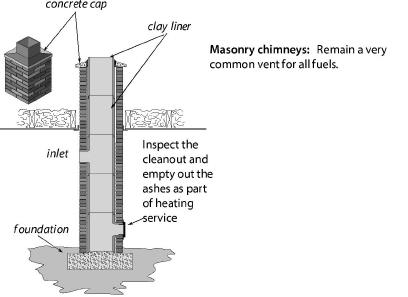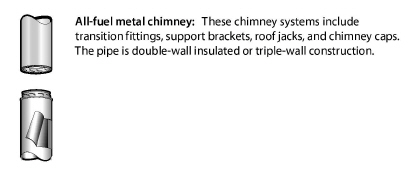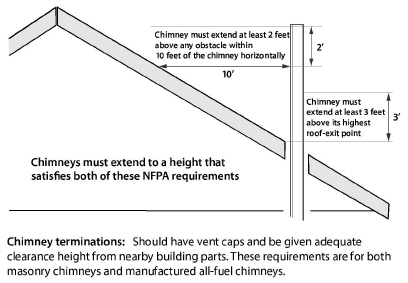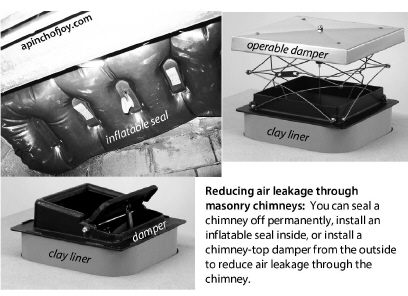
8.10 Chimneys
There are two common types of vertical chimneys for venting combustion fuels that satisfy NFPA and ICC codes. First there are masonry chimneys lined with fire-clay tile, and second there are manufactured metal chimneys, including all-fuel metal chimneys, Type-B vent chimneys for gas appliances, and Type L chimneys for oil appliances.
|
SWS Detail: 2.0203.2 Combustion Flue Gas—Orphaned Water Heaters |
Verify the following general specifications for building, inspecting, and repairing masonry chimneys.
• A masonry foundation should support every masonry chimney.
• Existing masonry chimneys should be lined with a fireclay flue liner. There should be a 1/2-inch to 1-inch air gap between the clay liner and the chimney’s masonry to insulate the liner. The liner shouldn’t be bonded structurally to the outer masonry because the liner needs to expand and contract independently of the chimney’s masonry structure. The clay liner can be sealed to the chimney cap with a flexible high-temperature sealant.

• Masonry chimneys should have a cleanout 12 inches or more below the lowest inlet. Clean mortar and brick dust out of the bottom of the chimney through the clean-out door, so that this debris won’t eventually interfere with venting.
• Seal the chimney’s penetrations through floors and ceilings with sheet metal and high-temperature sealant as a fire-stop and air barrier.
• Re-build deteriorated or unlined masonry chimneys as specified above or reline them as part of a heating-system replacement or a venting-safety upgrade. Or, install a new metal chimney instead of repairing the existing masonry chimney.
Metal Liners for Masonry Chimneys
Install or replace liners in unlined masonry chimneys or chimneys with deteriorated liners as part of heating system replacement. Orphaned water heaters may also need a chimney liner because the existing chimney may be too large. Use a correctly sized Type-B vent, a flexible or rigid stainless-steel liner, or a flexible aluminum liner.

Flexible liners require careful installation to avoid a low spot at the bottom, where the liner turns a right angle to pass through the wall of the chimney. Comply with the manufacturer’s instructions, which usually require stretching the liner and fastening it securely at both ends, to prevent the liner from sagging and creating a low spot.
Flexible liners are easily damaged by falling masonry debris inside a deteriorating chimney. Use B-vent, L-vent, or single-wall stainless steel pipe instead of a flexible liner when the chimney is significantly deteriorated.
To minimize condensation, insulate the flexible liner — especially when installed in exterior chimneys. Consider fiberglass-insulation jackets or perlite, if the manufacturer’s instructions allow. Wood-stove chimney liners must be stainless steel and insulated.
Sizing flexible chimney liners correctly is very important. Oversizing is common and can lead to condensation and corrosion. The manufacturers of the liners include vent-sizing tables in their specifications. Liners should display a label from a testing lab like Underwriters Laboratories (UL).
Masonry chimneys as structural hazards: A building owner may want to consider reinforcing a deteriorated chimney by re-pointing masonry joints or parging the surface with reinforced plaster. Other options include demolishing the chimney or filling it with concrete to prevent it from damaging the building by collapsing during an earthquake.
Solutions for Failed Chimneys
Sometimes a chimney is too deteriorated to be re-lined or repaired. In this case, abandon the old chimney, and install one of the following.
• A double-wall horizontal sidewall vent, equipped with a barometric draft control and a power venter mounted on the exterior wall. Maintain a 4-foot clearance between the ground and the vent’s termination if you live where it snows.
• A new heating unit, equipped with a power burner or draft inducer, that is designed for horizontal or vertical venting.
• A new manufactured metal venting system.
Manufactured metal chimneys have engineered parts that fit together in a prescribed way. Parts include: metal pipe, weight-supporting hardware, insulation shields, roof jacks, and chimney caps. One manufacturer’s chimney may not be compatible with another’s connecting fittings.
All-fuel chimneys (also called Class A chimneys) are used primarily for the solid fuels: wood and coal. All-fuel metal chimneys come in two types: insulated double-wall metal pipe and triple-wall metal pipe. Comply with the manufacturer’s specifications when you install these chimneys.

Type-B vent double-wall pipe is permitted as a chimney for gas appliances. Type BW pipe is manufactured for gas space heaters in an oval shape to fit inside wall cavities.
Type L double-wall pipe is used for oil chimneys.
Masonry chimneys and all-fuel metal chimneys should terminate at least three feet above the roof penetration and two feet above any obstacle within ten feet of the chimney outlet.

B-vent chimneys can terminate as close as one foot above flat roofs and above pitched roofs up to a 6/12 roof pitch. As the pitch rises, the minimum required termination height, as measured from the high part of the roof slope, rises as shown in this table.
|
flat- 6/12 |
6/12- 7/12 |
7/12- 8/12 |
8/12- 9/12 |
9/12- 10/12 |
10/12- 11/12 |
11/12- 12/12 |
12/12- 14/12 |
14/12- 16/12 |
16/12- 18/12 |
|
1' |
1' 3" |
1' 6" |
2' |
2' 6" |
3' 3" |
4' |
5’ |
6' |
7' |
|
From National Fuel Gas Code 2009 |
|||||||||
8.10.4 Air Leakage through Masonry Chimneys
|
SWS Detail: 4.1001.3 Fireplace Chimney and Combustion Flue Vents |
The existing fireplace damper or “airtight” doors seldom provide a good air seal. Help the customer decide whether the fireplace will be used in the future or whether it can be taken out of service. Consider these solutions for chimneys with ineffective or missing dampers.
• Install an inflatable chimney seal along with a notice of its installation to alert anyone wanting to start a fire to remove the seal first.
• Install an operable chimney-top damper and leave instructions on how to open and close it. Also notify users of which position is open and which is closed.
• Air seal the chimney top from the roof with a watertight, airtight seal. Also seal the chimney from the living space with foam board and drywall. If you install a permanent chimney seal such as this, post a notice at the fireplace saying that it is permanently disabled.
